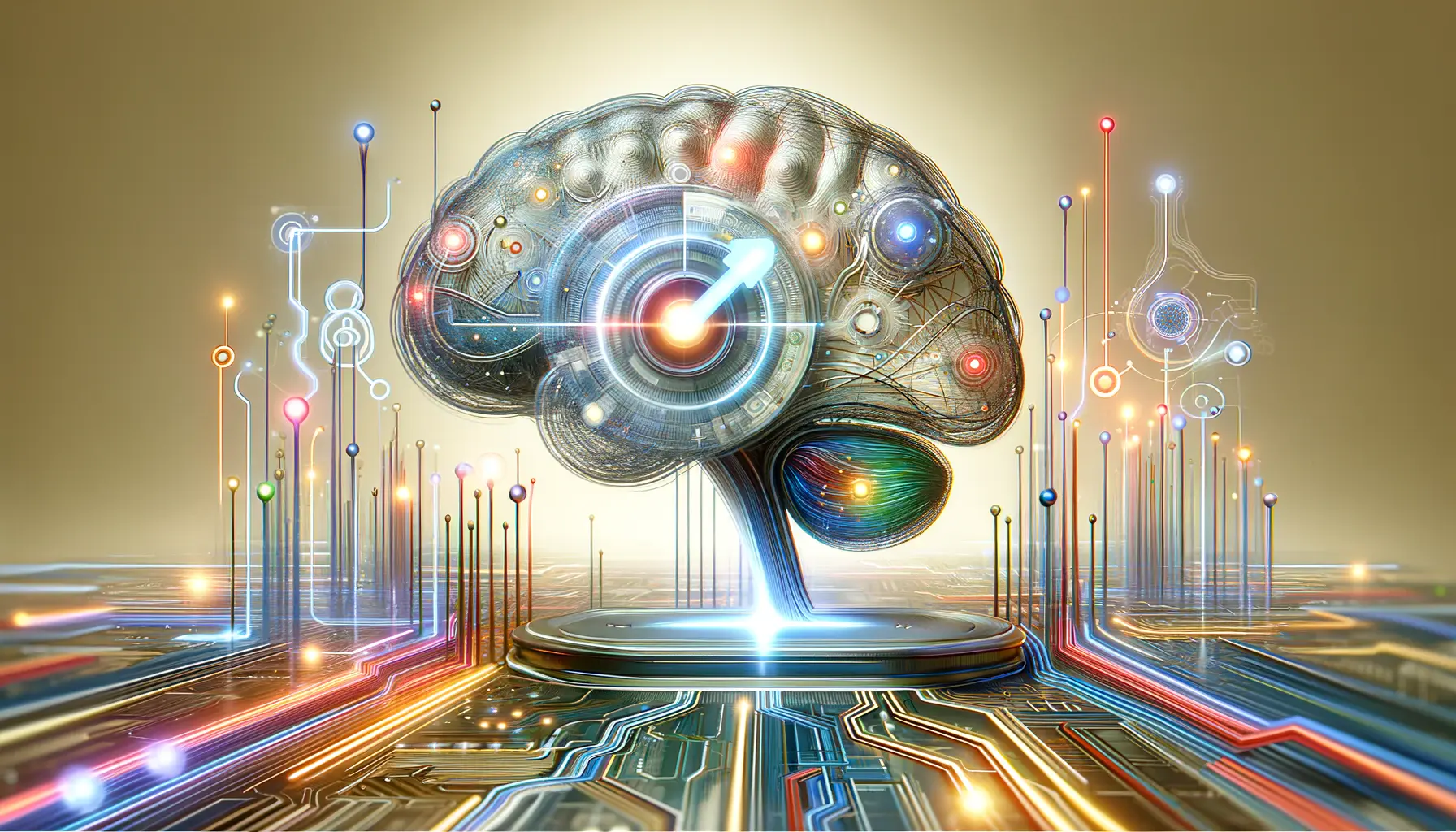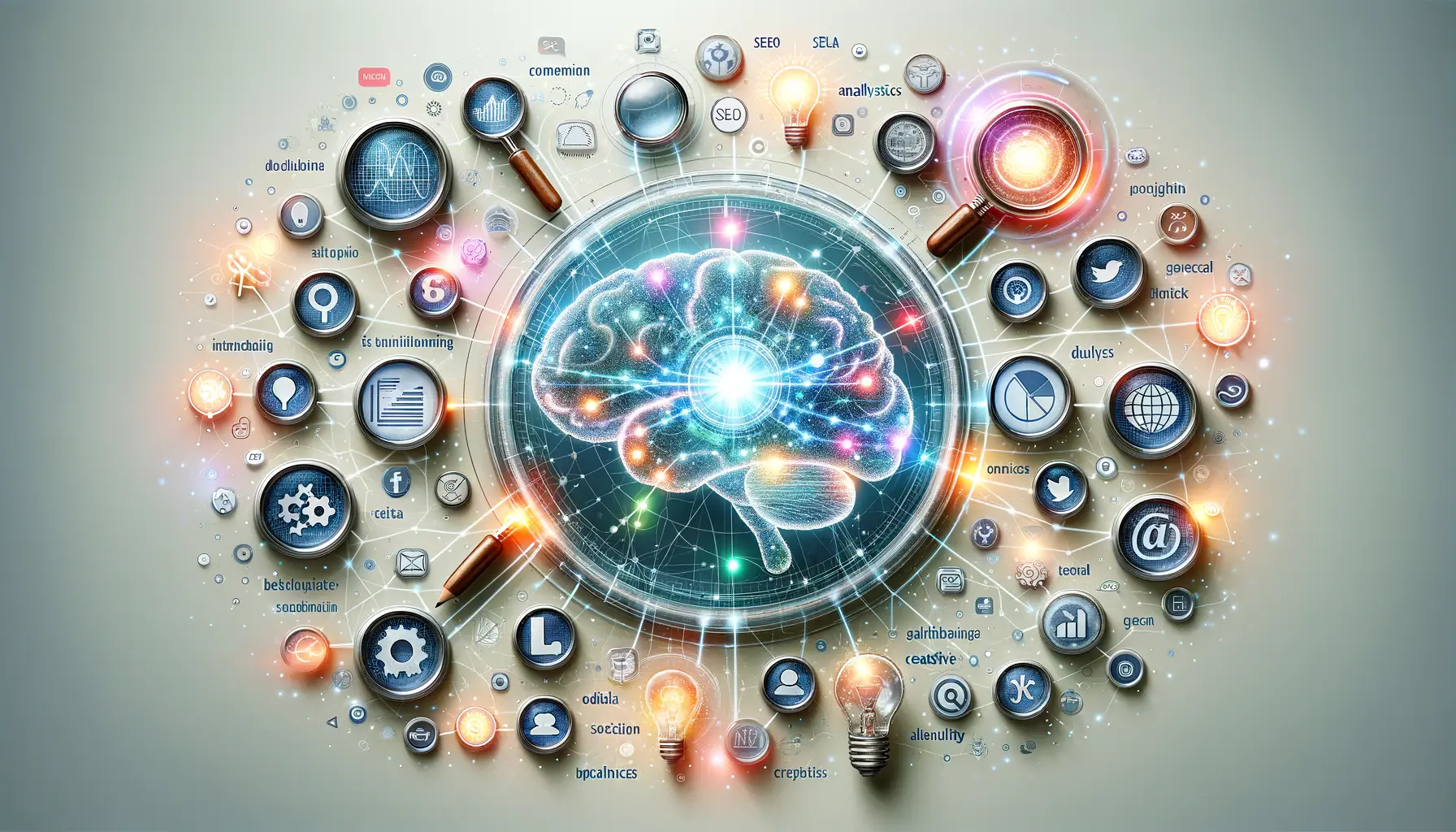The advent of Google’s Bard marks a significant milestone in the evolution of content marketing.
This innovative AI, developed by one of the tech giants, is set to redefine the way marketers create, distribute, and optimize content.
By leveraging natural language processing and machine learning, Bard offers unprecedented capabilities in generating human-like text, understanding user queries, and providing accurate, up-to-date information from the web.
This breakthrough technology not only promises to enhance the efficiency of content creation but also to elevate the quality of content available to audiences worldwide.
Google’s Bard is poised to transform content marketing strategies by offering tailored recommendations, optimizing conversion rates, and boosting overall efficiency.
Its ability to quickly transform complex data into engaging content and provide on-the-spot suggestions allows marketers to produce more content in less time, thereby freeing up resources for other critical tasks.
Bard’s introduction into the marketing toolkit opens up new avenues for creativity and strategic planning, enabling marketers to stay ahead in the competitive digital landscape.
- Understanding Google’s Bard and Its Capabilities
- Enhancing Personalization and Audience Engagement
- Optimizing Content for Search Engines
- Streamlining Content Workflow with Automation
- Leveraging Bard for Competitive Analysis
- Measuring and Enhancing Content Performance
- Future Trends in Content Marketing with Bard
- Embracing the Future of Content Marketing with Google’s Bard
- FAQs: Navigating the Impact of Google’s Bard on Content Marketing
Understanding Google’s Bard and Its Capabilities
What is Google Bard?
At its core, Google Bard is an AI-powered platform designed to simplify the content creation process for marketers.
Built on Google’s advanced LaMDA technology, Bard excels in understanding and generating natural language, making it an invaluable tool for creating diverse types of content.
From blog posts and email campaigns to social media updates, Bard’s versatility allows it to cater to various content marketing needs with ease.
Its real-time connectivity to the web ensures that the content it generates is not only relevant but also reflects the latest trends and information.
The introduction of Bard into the content marketing sphere is a testament to Google’s commitment to innovation.
By harnessing the power of AI, Bard aims to democratize content creation, making cutting-edge technology accessible to marketers regardless of their technical expertise or budget constraints.
This move is expected to level the playing field, allowing small businesses and large corporations alike to benefit from AI-driven content strategies.
Revolutionizing Content Creation
One of the standout features of Google Bard is its ability to revolutionize content creation.
Marketers can now generate ideas, draft content, and refine strategies with unprecedented speed and efficiency.
Bard’s AI analyzes existing videos, webpages, and other content forms to offer personalized suggestions that align with specific marketing goals.
This not only enhances the creativity of content but also ensures that it resonates with the target audience.
Furthermore, Bard’s impact on content marketing extends beyond mere content generation.
It offers strategic insights that help marketers align their content with broader business objectives.
Whether it’s improving website conversion rates or crafting compelling calls to action, Bard provides guidance rooted in data analysis and consumer psychology.
This strategic direction is crucial for businesses looking to leverage content marketing for growth and engagement.
Google Bard’s real-time data access and AI-driven recommendations are set to revolutionize content marketing, offering new levels of efficiency, creativity, and strategic insight.
Enhancing Personalization and Audience Engagement
The digital age demands a personalized approach to content marketing, and Google’s Bard is stepping up to meet this challenge.
By leveraging AI to analyze user data and behavior, Bard enables marketers to craft content that speaks directly to the interests and needs of their audience.
This level of personalization is not just about tailoring messages; it’s about creating a unique and engaging experience for each user, thereby fostering a deeper connection between brands and their customers.
Personalization at Scale
One of Bard’s most significant contributions to content marketing is its ability to personalize content at scale.
Traditional methods of personalization often require extensive resources and can be time-consuming.
Bard, however, simplifies this process by:
- Automatically generating content variations targeted at different audience segments.
- Providing insights into user preferences and behaviors, allowing for more accurate targeting.
- Enabling dynamic content adjustment based on real-time user interactions and feedback.
This capability ensures that marketers can deliver personalized content to a broad audience without compromising on quality or relevance.
Boosting Audience Engagement
Engagement is the currency of the digital marketing world, and Bard is well-equipped to help marketers increase their wealth.
Through its advanced language models, Bard can create content that is not only personalized but also highly engaging.
This includes:
- Interactive content that encourages user participation and feedback.
- Emotionally resonant stories that connect with users on a personal level.
- Content optimized for various platforms, ensuring a consistent and engaging user experience across all touchpoints.
By enhancing audience engagement, Bard helps brands build loyalty, increase retention, and drive conversions, making it an indispensable tool in the modern marketer’s arsenal.
Leveraging Bard for personalization and engagement can transform the way brands interact with their audience, making every piece of content a step towards building stronger customer relationships.
Optimizing Content for Search Engines
In the realm of digital marketing, visibility is paramount.
Google’s Bard not only excels in creating compelling content but also plays a crucial role in optimizing that content for search engines.
SEO (Search Engine Optimization) is a critical component of content marketing, ensuring that your content reaches its intended audience through higher search engine rankings.
Bard’s understanding of SEO principles and its ability to analyze vast amounts of data make it an invaluable ally in this endeavor.
By integrating Bard into your SEO strategy, you can leverage its AI capabilities to enhance your content’s relevance and visibility.
This involves a multifaceted approach, combining keyword optimization, content structuring, and quality content creation to meet the ever-evolving algorithms of search engines.
Keyword Optimization and Strategy
Bard’s AI technology offers a sophisticated understanding of keyword relevance and search intent.
It assists in:
- Identifying high-value keywords and phrases related to your content and audience.
- Strategically incorporating these keywords into your content without compromising natural language and readability.
- Analyzing competitor keyword strategies to uncover gaps and opportunities for differentiation.
This targeted approach to keyword optimization ensures that your content not only attracts the right audience but also aligns with search engine criteria for higher rankings.
Improving Content Structure and Quality
The structure and quality of your content are critical factors in SEO.
Bard helps to:
- Organize content in a way that enhances readability and user engagement, utilizing headings, subheadings, and lists for better navigation.
- Ensure content quality by providing suggestions for depth, accuracy, and comprehensiveness, addressing the needs and questions of your audience.
- Optimize meta descriptions, title tags, and other on-page SEO elements to improve click-through rates and search engine visibility.
With Bard’s assistance, marketers can create content that not only resonates with their audience but also performs well in search engine rankings, driving organic traffic and engagement.
SEO optimization with Bard is not just about following algorithms; it’s about creating valuable, relevant content that serves the needs of your audience while meeting search engine criteria.
Streamlining Content Workflow with Automation
The integration of Google’s Bard into content marketing strategies significantly streamlines the content creation and distribution process.
Automation, a key feature of Bard, allows for the efficient handling of repetitive tasks, freeing up marketers to focus on strategy and creative development.
This automation extends across various aspects of content marketing, from research and writing to publishing and analytics.
By automating the content workflow, Bard not only enhances productivity but also ensures consistency in content quality and brand messaging.
This is crucial for maintaining a strong online presence and building trust with your audience.
Automating Content Creation and Editing
Bard’s capabilities in automating content creation and editing processes are transformative.
It can:
- Generate initial drafts based on brief inputs, significantly reducing the time spent on content writing.
- Offer suggestions for content improvement, including language refinement and structure optimization, ensuring that the final output is polished and engaging.
- Identify and correct grammatical errors and inconsistencies, maintaining a high standard of content quality.
This level of automation in content creation and editing not only speeds up the production process but also enhances the overall quality of the content.
Enhancing Content Distribution and Analysis
Bard’s impact extends beyond creation and editing to include content distribution and performance analysis.
Through automation, Bard can:
- Schedule and publish content across multiple platforms, ensuring timely and consistent delivery to your audience.
- Analyze content performance data, providing insights into engagement metrics, audience behavior, and content optimization opportunities.
- Automate reporting, allowing marketers to quickly assess the effectiveness of their content strategies and make data-driven decisions.
The automation of these processes not only streamlines the content workflow but also provides valuable insights that can inform future content strategies.
The automation capabilities of Google’s Bard revolutionize content marketing by enhancing efficiency, consistency, and strategic insight, making it an indispensable tool for modern marketers.
Leveraging Bard for Competitive Analysis
Understanding the competitive landscape is crucial for any content marketing strategy.
Google’s Bard offers a unique advantage in this area by enabling marketers to conduct comprehensive competitive analyses with ease.
By leveraging Bard’s vast data processing capabilities and real-time internet access, marketers can gain insights into their competitors’ content strategies, audience engagement, and SEO tactics.
This information is invaluable for identifying gaps in the market, uncovering new opportunities, and refining your content strategy to stay ahead of the competition.
Bard’s ability to analyze and interpret data from a wide range of sources ensures that the insights you gain are both accurate and actionable.
This empowers marketers to make informed decisions that can significantly impact their content marketing success.
Identifying Content Gaps and Opportunities
One of the key benefits of using Bard for competitive analysis is its ability to identify content gaps and opportunities.
By analyzing competitors’ content, Bard can help you:
- Discover topics that are underrepresented in your industry, providing a chance to lead the conversation and attract a new audience.
- Understand the types of content that resonate with your target audience, allowing you to tailor your content strategy to meet their needs more effectively.
- Identify high-performing content formats and channels, enabling you to optimize your content distribution for maximum impact.
This strategic insight into the competitive landscape allows you to differentiate your brand and capture the attention of your target audience.
Enhancing SEO Strategies
Beyond content creation, Bard’s competitive analysis capabilities extend to SEO.
By examining competitors’ SEO strategies, Bard can provide recommendations for:
- Improving keyword targeting and optimization to increase your content’s visibility in search engine results.
- Adopting best practices in on-page and off-page SEO to enhance your website’s authority and search rankings.
- Identifying backlink opportunities to strengthen your SEO efforts and drive organic traffic to your site.
Leveraging Bard for competitive analysis in SEO not only improves your content’s performance but also strengthens your overall online presence, making it easier for potential customers to find you.
Competitive analysis with Google’s Bard offers a strategic advantage, enabling marketers to uncover gaps, seize opportunities, and refine their strategies for enhanced content marketing success.
Measuring and Enhancing Content Performance
One of the most critical aspects of content marketing is the ability to measure and enhance the performance of your content.
Google’s Bard plays a pivotal role in this process by providing advanced analytics and insights that help marketers understand how their content is performing across various platforms.
With Bard’s AI-driven analysis, marketers can dive deep into engagement metrics, audience behavior, and conversion rates, enabling them to make data-driven decisions to optimize their content strategy for better results.
By leveraging Bard’s capabilities, marketers can identify which pieces of content are resonating with their audience, which SEO strategies are driving traffic, and where there are opportunities for improvement.
This continuous cycle of measurement and optimization is essential for maximizing the ROI of content marketing efforts.
Advanced Analytics for Content Optimization
Bard’s advanced analytics provide a comprehensive view of content performance, including:
- User engagement metrics such as time spent on page, bounce rate, and social shares.
- SEO performance indicators like keyword rankings, organic traffic, and backlink profiles.
- Conversion data, including click-through rates, lead generation statistics, and sales attributed to specific content pieces.
This wealth of data allows marketers to pinpoint exactly what’s working and what’s not, facilitating targeted adjustments to content and strategy.
Strategies for Content Enhancement
Armed with insights from Bard, marketers can employ various strategies to enhance their content’s performance, such as:
- Refining content topics and formats based on audience preferences and engagement data.
- Optimizing content for search engines by adjusting keywords, meta tags, and content structure.
- Improving content distribution across channels to reach a wider audience and drive more traffic.
- Experimenting with different calls to action and content offers to increase conversions and generate more leads.
These targeted strategies, informed by Bard’s analytics, enable marketers to continually refine their content approach, ensuring that their marketing efforts are as effective as possible.
Measuring and enhancing content performance with Google’s Bard allows marketers to unlock the full potential of their content marketing strategy, driving increased engagement, traffic, and conversions.
Future Trends in Content Marketing with Bard
The landscape of content marketing is ever-evolving, and with the advent of AI technologies like Google’s Bard, we are on the cusp of a new era.
Bard’s introduction into the content marketing toolkit signifies a shift towards more intelligent, data-driven strategies that can adapt in real-time to the changing preferences of audiences and the dynamics of search engines.
As we look to the future, several trends are emerging that highlight the growing importance of AI in shaping effective content marketing strategies.
Embracing these trends will be crucial for marketers seeking to stay ahead of the curve and leverage the full power of Bard to achieve their content marketing goals.
AI-Driven Personalization and Automation
The future of content marketing lies in personalization and automation, with Bard leading the charge.
Marketers can expect to see:
- Increased use of AI to create highly personalized content experiences for individual users, enhancing engagement and loyalty.
- Greater reliance on automation for content creation, distribution, and optimization, freeing marketers to focus on strategy and innovation.
This shift towards AI-driven processes will enable marketers to deliver more relevant, engaging content at scale, meeting the demands of modern consumers for personalized experiences.
Real-Time Content Optimization
With Bard’s ability to access and analyze real-time data, content optimization will become more dynamic and responsive.
Future trends include:
- Adapting content strategies in real-time based on audience behavior and market trends, ensuring maximum relevance and impact.
- Using AI to predict content performance and make adjustments before publishing, increasing the likelihood of success.
This proactive approach to content optimization will allow marketers to stay one step ahead, ensuring their content resonates with audiences and achieves desired outcomes.
Enhanced Content Discovery and Distribution
Bard’s impact on content marketing extends beyond creation and optimization to include discovery and distribution.
Upcoming trends involve:
- Leveraging AI to identify the best channels and formats for content distribution, maximizing reach and engagement.
- Using Bard’s insights to enhance content discoverability through SEO and social media, driving organic traffic and visibility.
By harnessing Bard’s capabilities for content discovery and distribution, marketers can ensure their content is seen by the right audience at the right time, amplifying their marketing efforts.
The integration of Bard into content marketing heralds a future where AI-driven personalization, real-time optimization, and enhanced content discovery become the norm, setting the stage for more effective and impactful marketing strategies.
Embracing the Future of Content Marketing with Google’s Bard
The integration of Google’s Bard into the realm of content marketing heralds a transformative era for marketers and brands alike.
As we have explored, Bard’s capabilities extend far beyond mere content generation, offering a suite of tools designed to enhance personalization, streamline workflows, optimize for search engines, and provide actionable insights through competitive analysis.
The future of content marketing, powered by AI like Bard, promises a landscape where strategies are not only more effective but also more aligned with the dynamic needs and preferences of audiences.
The Strategic Advantage of Bard in Content Marketing
Google’s Bard offers a strategic advantage to marketers by automating complex processes, enabling real-time content optimization, and facilitating deeper audience engagement through personalized content.
These capabilities allow for:
- Efficient scaling of content production without sacrificing quality or relevance.
- Dynamic adaptation of content strategies based on evolving market trends and consumer behaviors.
- Enhanced ability to compete in saturated markets by identifying and leveraging unique content opportunities.
As content marketing continues to evolve, the integration of Bard into marketing strategies will become increasingly critical for those looking to maintain a competitive edge.
Preparing for a Bard-Driven Content Marketing Future
To fully leverage the potential of Google’s Bard, marketers must prepare for a future where AI-driven tools are at the forefront of content strategy.
This preparation involves:
- Investing in AI literacy and training for marketing teams to maximize the use of Bard’s capabilities.
- Developing agile content strategies that can quickly adapt to insights and recommendations provided by Bard.
- Embracing a data-driven approach to content marketing, with a focus on continuous optimization and personalization.
By taking these steps, marketers can ensure that they are not only ready to use Bard effectively but also positioned to lead in the new era of content marketing.
Conclusion
The impact of Google’s Bard on content marketing is undeniable.
As we look to the future, it’s clear that Bard represents more than just an advancement in AI technology; it signifies a shift towards more intelligent, responsive, and personalized content marketing strategies.
By embracing Bard, marketers can unlock new levels of creativity, efficiency, and engagement, driving success in an increasingly digital world.
The journey with Bard is just beginning, and the possibilities for transforming content marketing are as vast and exciting as the technology itself.
FAQs: Navigating the Impact of Google’s Bard on Content Marketing
Explore common queries about leveraging Google’s Bard in your content marketing strategy.
Google Bard is an AI-driven tool designed to enhance content creation, offering real-time data analysis and personalized content recommendations.
Bard analyzes search trends and user queries, providing valuable SEO insights to optimize content for better search engine visibility.
Yes, Bard can automate content creation, from generating initial drafts to suggesting improvements, streamlining the content workflow.
Yes, Bard supports over 40 languages, enabling global reach through multilingual content creation and optimization.
Bard creates interactive and emotionally resonant content, tailored to audience preferences, to boost engagement and loyalty.
Yes, Bard can conduct competitive analyses, identifying content gaps and opportunities to refine your strategy against competitors.
Bard can optimize content distribution across channels, ensuring content reaches the intended audience effectively.
Bard anticipates trends towards more AI-driven personalization, real-time content optimization, and enhanced content discovery.












